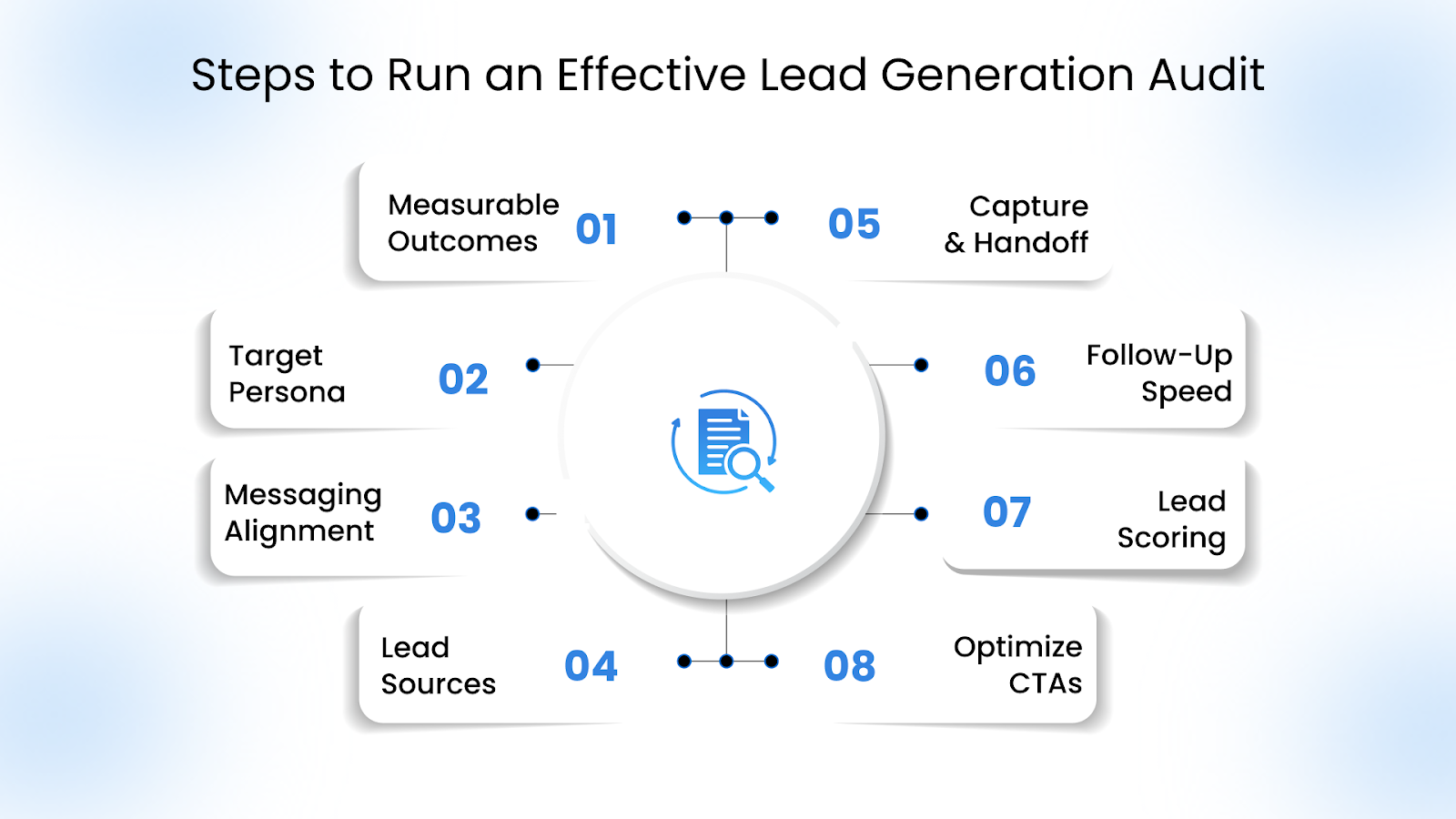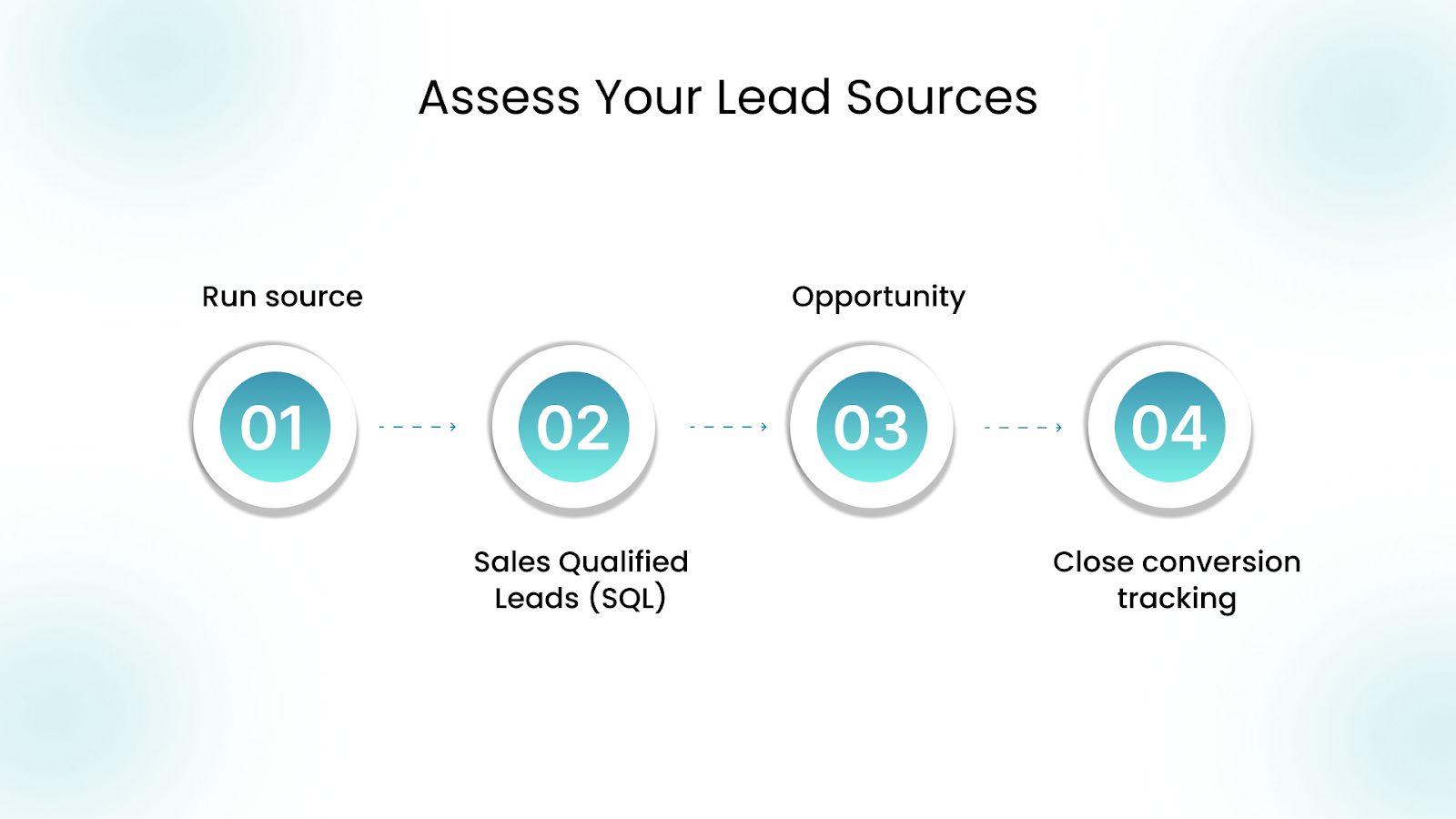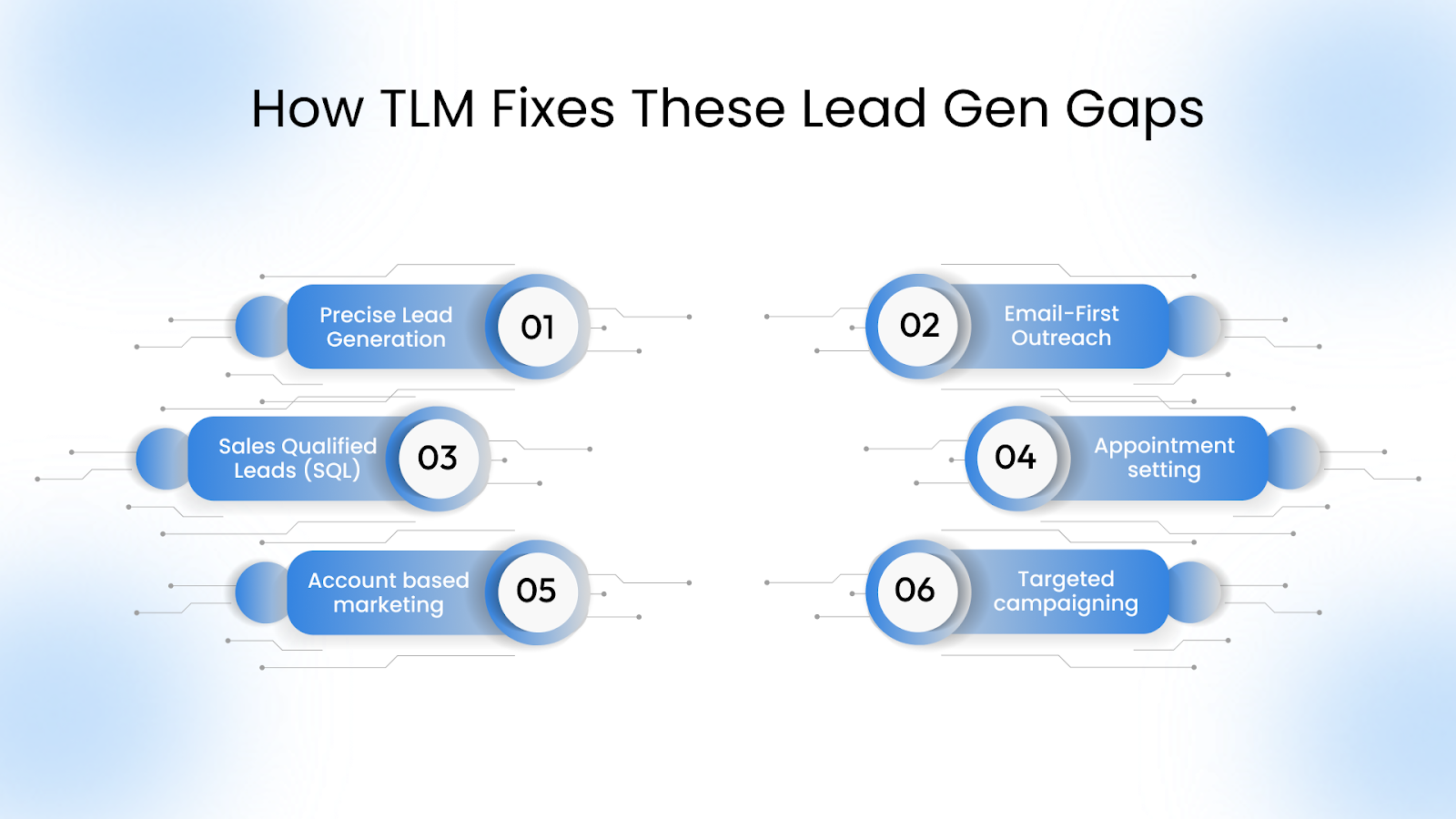
Lead Generation Audit for B2B Companies: A Step-by-Step Guide

B2B teams often fine-tune their outreach, messaging, and targeting—but results still fall short. A major reason? Lack of visibility into what's actually working.
According to Marketing Week, more than 40% of B2B marketers are under pressure to deliver marketing-qualified leads regardless of quality, and nearly 70% say lead generation has become a bigger focus than it was three years ago. That shift in pressure, combined with rising targets, often leads to quantity being prioritized over quality.
The result: bloated pipelines filled with unqualified or misaligned leads, misused resources, and lower conversion rates.
In fact, around 42% of B2B companies report that low-quality or irrelevant leads are one of their top challenges, disrupting performance and slowing pipeline momentum. Gaps in targeting, qualification, and follow-up often go undetected, especially when teams rely on assumptions rather than data.
A lead generation audit changes that. It gives teams a structured way to evaluate their funnel, spotting breakdowns in process, pinpointing where leads are falling off, and clarifying what’s truly driving results.
This guide walks through nine actionable steps to run a focused lead generation audit, one that sharpens your strategy, improves lead quality, and strengthens your path to revenue.
TL;DR:
- A lead generation audit identifies weak spots in your sales funnel.
- Key audit steps include defining measurable goals, aligning messaging with your Ideal Customer Profile, assessing lead sources, and optimizing follow-up speed.
- Common gaps found are low-intent leads, misaligned personas, and weak calls-to-action that stall pipeline momentum.
What Is a Lead Generation Audit?
A lead generation audit is a step-by-step review of how you attract, qualify, and follow up with leads. It helps you find where the process is underperforming, like poor targeting, weak email response, slow follow-ups, or unqualified leads getting passed to sales.
Instead of guessing why conversions are low, the audit shows exactly which parts of your lead funnel need fixing. It focuses on data, not assumptions, and helps you improve lead quality, conversion rates, and pipeline performance.
Top Steps to Run an Effective Lead Generation Audit

A lead generation audit helps you spot what's broken before it costs you pipeline. Here are the key steps to run it right.
Step 1: Start with Measurable Outcomes
Before optimizing forms or outreach sequences, take a moment to ask: What are we trying to accomplish, and how are we measuring it? Too often, teams optimize touchpoints without clearly defining the goal. Leads may be flowing in, but if they don’t convert, what’s the value?
Pull recent lead data. Look at how many become Sales Qualified Leads (SQLs), how many enter the pipeline, and how many actually close. Now reverse-engineer: Are your campaigns attracting the right leads? Or are you measuring success by volume alone?
If your outcomes aren’t clearly defined, your audit will only scratch the surface.
Quick Tips:
- Benchmark: Track lead > SQL > Opportunity > Closed-Won% % across channels.
- Separate high-intent from low-fit leads. Measure both.
- Avoid vanity metrics like open rates when evaluating outcomes.
Step 2: Define Your Target Persona with Precision
Even great campaigns fall flat if they’re aimed at the wrong people. During your audit, compare your actual leads against your Ideal Customer Profile (ICP). Look beyond job title, think company size, industry, pain points, and buying triggers.
Audit recent SQLs and closed-won deals. Do they match your ICP? Or are you spending resources on leads that never had real potential?
Also, review your targeting logic: Are list pulls, ad filters, or SDR prospecting rules aligned with your ICP? Or are gaps in your persona definitions sending mixed signals?
Step 3: Align Messaging with Prospect Intent
Your messaging may sound good, but is it landing? Audit the copy in your email sequences, landing pages, and ads. Then compare it to actual prospect behavior.
If replies are low or responses are vague, chances are you’re not hitting the right pain point or stage of intent. Tailor your messaging based on where the buyer is: Are they just exploring? Actively looking? Comparing vendors?
Don’t just audit copy for polish, audit it for relevance and timing.
Step 4: Assess Your Lead Sources

Not all lead sources are equal. Some fill the pipeline. Others clog it.
During the audit, break down your sources: outbound email, ads, referrals, case study downloads, etc. Track which ones actually turn into SQLs and closed deals, not just top-of-funnel form fills. The goal here isn’t to cut back, it’s to double down on what drives revenue and trim what’s wasting time.
Quick Tips:
- Run source > SQL > Opportunity > Close conversion tracking for each channel.
- Flag sources with high form fills but low conversions.
- Prioritize channels where sales says, “These leads are solid.”
Step 5: Evaluate Your Lead Capture and Handoff Process
High-intent leads mean nothing if they’re trapped in a broken system. Audit how leads are collected, routed, and handed over to sales.
Is the lead form capturing useful data (e.g., industry, role, budget)? Are SDRs getting full context, or just an email address? A poor handoff adds friction, delays response time, and lets leads go cold. Map the handoff path—from form fill or reply → SDR → appointment scheduling. Find where leads slow down.
Step 6: Check Follow-Up Speed and Cadence
Speed matters. If your team isn’t following up quickly, you’re losing good leads to competitors. Audit response times across all lead sources, form fills, demo requests, campaign replies. Then look at cadence: Are reps sending just one email and forgetting? Or is there a structured multi-touch sequence? Consistency is what turns interest into meetings.
Step 7: Analyze Qualification Criteria and Lead Scoring
Audit how leads are being qualified. Are reps using clear criteria, or is it gut feel? Are good leads being rejected too early, or worse, are poor leads slipping through because the bar is too low?
If you use lead scoring, review the rules. Is it behavior-based? Role-based? Intent-driven? An outdated scoring system can quietly derail your funnel.
Step 8: Review and Optimize Your CTAs
Even warm leads need direction. CTAs (calls-to-action) are often overlooked, but a vague or misaligned CTA can kill momentum.
Audit all your CTAs: emails, landing pages, LinkedIn messages. Are they clear? Relevant? Easy to act on? A “Let’s connect” CTA won’t work for someone ready to book an appointment.
Also, check the placement. A strong CTA buried at the bottom of a long message won’t get clicked.
Quick Tips:
- Match CTA to funnel stage: “See pricing” vs. “Download guide.”
- Test static vs. floating CTAs in landing pages.
- Use one clear CTA per message. No split focus.
Gaps a Lead Generation Audit Can Reveal

Even the most active sales pipeline can hide silent blockers. A proper audit brings those weak spots to the surface so you’re generating leads and revenue.
Here are some of the most common gaps a lead generation audit uncovers:
- Low-Intent or Mismatched Leads: You’re booking meetings, but not with decision-makers or ICPs. This clogs the pipeline and frustrates sales.
- Slow or Inconsistent Follow-Up: Hot leads go cold because responses aren't timely or structured. Even a few hours of delay can kill momentum.
- No MRR Visibility: Leads are being tracked, but there’s no way to connect them to closed deals or recurring revenue. You’re flying blind on ROI.
- Misaligned Persona Targeting: Outreach doesn’t resonate because it’s based on assumptions, not recent SQL or deal data.
- Dropped Handoffs Between Teams: Leads fall through the cracks when SDRs don’t have context or sales isn’t equipped to close.
How TLM Fixes These Lead Gen Gaps

With over 9 years of experience, The Lead Market (TLM) helps B2B companies fix what most lead engines miss: unqualified leads, poor follow-ups, and broken conversions.
Here’s how our specialized services close the gaps:
- Precision-Based Lead Generation
We run targeted campaigns built around your Ideal Customer Profile (ICP). That means outreach tailored by industry, role, geography, and company size. - Email-First Outreach, Not Cold Calls
Our approach to email marketing uses structured, multi-touch sequences to engage prospects naturally. No disruptive calling or LinkedIn spamming. - Only Sales Qualified Leads (SQL) Delivered
We qualify every lead before it hits your pipeline, based on fit, intent, and activity, so your sales team only talks to those ready to move forward. - Appointment Setting
Our SDRs schedule meetings directly with qualified leads, sharing full lead context and syncing with your team’s availability to avoid no-shows. - Account-Based Marketing (ABM) for High-Value Targets
Our ABM strategy focuses outreach on your most valuable accounts with personalized messaging that speaks directly to pain points and decision triggers. - Targeted Campaigning that Scales
Every campaign is optimized by audience segment and tracked in real-time, helping you reach the right decision-makers faster.
Final Thoughts
To sum it up, a lead generation audit reveals where your sales funnel is falling short, turning guesswork into precise action. It’s a powerful tool for identifying gaps in targeting, qualification, and follow-up that might be draining your resources. Regular audits ensure you're actively improving it, so you’re always a step ahead of shifting buyer needs. By continuously refining your process, you build a stronger, more efficient pipeline that brings in better leads and drives more meaningful revenue.
FAQs
1. Why is a lead generation audit important for B2B companies?
A lead generation audit helps B2B teams identify where their sales funnel is underperforming, whether it’s poor targeting, low engagement, or slow follow-ups.
2. What should I look for during a lead generation audit?
Focus on targeting accuracy, email engagement rates, qualification criteria, follow-up cadence, and the quality of SQLs passed to sales. These elements directly impact your pipeline velocity and MRR.
3. How often should I run a lead generation audit?
Ideally, every quarter. Regular audits ensure your lead gen strategy stays aligned with changing buyer behavior and market trends.






